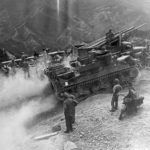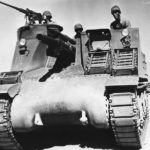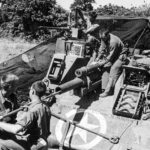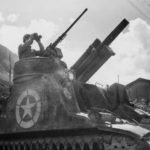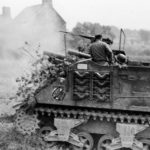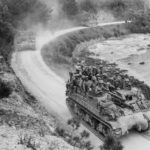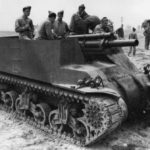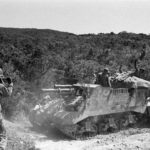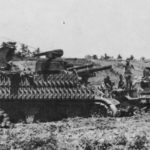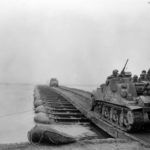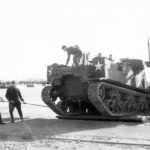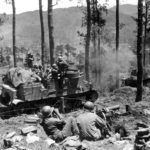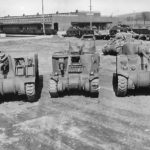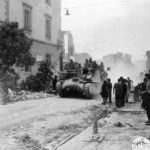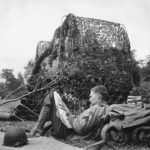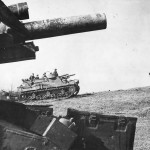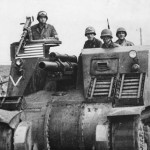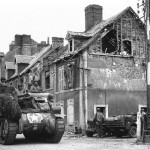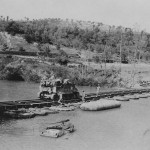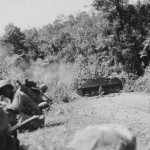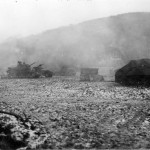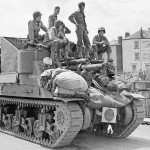M7 September 1943 North Africa
M7 of 3rd Armored Division in Eichelhart 27 March 1945
M7 on Tinian
M7 Italy
M7 from 3rd Armored Division takes counter-battery hit Bulge 16 January 1945
M7 tested for Desert Warfare at Iron Mountains, California
Crew of a 6th Armored Division swabs the tube of M7 late Summer 1944
M7 of 10th Mountain, 1125th Armored Field Artillery Bn, Lake Garda, Italy 30 April 1945
Priest firing at St Pois France 3 August 1944
29th Marines hitch ride on M7 moving along a coastal road near Ghuta Village Okinawa, April 1945
Prototype T32
M7 in Aberdeen Proving Ground 1943
M7 with trailer
M7 interior, 17 January 1944, Italy
M7 of 5th Armored Division fires on German ammo barges Rhine River 5 March 1945
M7 of 10th Armored Division firing near Heidelberg 30 March 1945
M7 from 79th Infantry Division Wissonbourg, France 15 December 1944
M7 Luzon 1945
M7 Okinawa May 1945
M7 Okinawa
M7 of 4th Armored Division pontoon bridge across Rhine Hanau 28 March 1945
M7 supports 17th Airborne 517th PIR Morhet Belgium 9 January 1945
105mm Howitzer Motor Carriage on Luzon Philippines February 1945
M7 of the 1st Armored Division is being unloaded at Algerian Docks November 9, 1942
U.S. 68th Armored Field Artillery Battalion M7 Priest named “Anna”, Anzio 1944
M7 Priest and US infantrymen advancing on Catman Hill on Leyte
37th Infantry Division M7 Priest, M1917 and M4 fighting near Baguio Luzon 1945
M7, M3 And M4 tanks at Schenectady Army Depot, Voorheesville NY
US 25th Division troops and M7 Priest named “Hairless Joe” advancing through the Caraballo mountains on Luzon 1945
M7 of the 4th Armored Division, Coutances, Normandy 1944
M7 Priest “Super Rabbit” from 40th Infantry Division firing on Luzon hill 1945
M7 Priest in action at Goth Line, Italy
M7 Priest at Sciacca, Sicily 1943
Camouflaged row of M7s stands on a country road ready for the go signal for the opening of the second front in Europe
M7 Priest from 1st Armored Division, 5th Army in Roccastrada, Italy 1944
Artillery guns blast Japanese position on Luzon
Soldier reads newspaper by camouflaged M7 near Carentan, 1944
M7 Priests of the 40th Infantry Division on Hill 1700 1-2 Philippines
Camouflaged M7 Normandy, 1944
British 8th Army M7 Priest Self Propelled Guns near Rome
M7 Priest 105 mm Howitzer Motor Carriage Interior
M7 Priest 105 mm HMC 135th Infantry 34th Division in Algeria 1942
M7 Priest in Carentan Normandy
British Priest Italy in late June 1944
M7 Priest and Sherman ARV M32
11h Armored Division M7B1 Priest battery rolls into burning Obernust, Germany April 1945
3rd Division M7 Priest At Volturno River Italy
M7 Priest 105mm Self Propelled Gun in Action, Luzon Philippines ’45
M7 Priest in action, 3rd Armored Division Germany January 1945
M7 Priest 105 mm Howitzer, Portland 1 June 1944
US Army M7 Priest in Phillipines
3rd Infantry Division Troops and M7 Priest Cori Italy 1944
10th Mountain Division M7 Priest Firing Near Lake Garda Italy 1945
M7 Priest 637th Tank Destroyers Support 37th Infantry Magot River Northern Luzon
M7 Priest Self Propelled Howitzer Finalist at Fort Knox 1942
M7 Priest 105 mm Howitzer Motor Carriage Enters Luxembourg December 22 1944
The 105 mm Howitzer Motor Carriage M7 Priest was an American self-propelled artillery vehicle produced during World War 2.
After the outbreak of World War II, American observers realised the need to have a self-propelled artillery vehicle with a suitably large gun suitable for supporting infantry operations. Earlier experience with the T19 has shown that such a vehicle must be armoured and have tracked chassis. For the production of the new vehicle, it was decided to use the M3 Lee medium-tank chassis. The vehicle has been granted a provisional mark T32. It was armed with an 105 mm M1A2 howitzer and a M2 machine gun. After field trials, howitzer was adopted for armament in February 1942 under the designation M7. The series production started a month later.
Two prototypes were ordered from ALCO (American Locomotive Company). Prototypes were ready in January 1942. They were directed to the Aberdeen Proving Ground in Maryland. The tests were positive and after minor changes, the first prototype was sent in February to Fort Knox for operational tests. At the same time, the second prototype, left on the Aberdeen proving ground, underwent major modifications. The silhouette has been reduced by rebuilding the howitzer mountings. However, this was associated with a reduction of the maximum barrel angle from 65 degrees to 35 degrees. The sides of the combat compartment were lowered by 28 cm, and the front panel was increased by 7.6 cm for better armoured protection. The repositioning of munitions has resulted in the possibility of transporting more projectiles – from 44 to 57.
M7 production started in the American Locomotive Company at the end of March 1942. The first serial vehicles were ready in the first days of April 1942. The first two copies were delivered to Aberdeen on 6 April for operational testing. Shortly afterwards, deliveries of serial vehicles to artillery units began. By the end of 1942, 2028 vehicles had been built. The production of the basic version was completed in August 1943. Until that time a total of 2814 Priests were built. Some changes have been made during production. The most visible was the replacement of the three-part, front, bottom part of the hull with a one-piece part. However, this required the replacement of the main power transmission system from the Iowa Transmission Company (which, contrary to its name, was located in Dover in Delaware) to the system of Caterpillar Inc. of East Pretoria, Illinois. This change was introduced in December 1942. At that time, M4 Sherman parts were also installed in the chassis in place of the older ones from the M3 Lee.
90 vehicles were delivered to the UK 8th Army in North Africa in mid-1942. They reached the 11th Field Regiment, Royal Artillery from the 1st Armoured Division, which used them at El Alamein. Another unit equipped with these vehicles was 24th Field Regiment. He took part in battles in Sicily, Italy and Anzio. British howitzers have been equipped with radio stations, at the expense of reducing the ammunition stockpile. The British were very satisfied with this vehicle, so they ordered 5,500 copies. The M7 had a lower figure, was more comfortable and much more reliable than their failed Bishop. Problems with deliveries untypical for British troops caused the need of British soldiers to mount their own 25-pdr howitzer. However, U.S. did not want to produce such vehicle and delay production for their own use. In June 1942 a prototype of a vehicle with a British gun was created and named 25 pounder Gun Motor Carriage T51, but it was not put into mass production. The British order was completed in Canada, where a Sexton self-propelled gun was created on the Ram tank chassis. The overall layout and concept of Sexton’s operation was similar to that of the M7. They were mainly different in terms of their equipment, combat compartment and slightly different chassis. The production of this guns started at the beginning of 1943 and was completed in 1945. A total of 2150 Sextons were produced.
In the second half of 1943, the demand for M7 appeared again, partly for further formed armoured divisions, and partly for the purpose of replenishing the losses and worn-out howitzers in the existing units. In March 1944, the production of the wagons was resumed, but in a slightly modified form. The main change was the use of the M4A3 Sherman tank chassis, the most popular type of vehicle chassis in US Army, using Ford car engine instead of Continental aircraft engine. The bottom of the vehicle is also thickened from 13 mm to 25-28 mm. The production of the new version marked M7B1 started in March 1944. At that time, ALCO produced 500 howitzers, which resulted in a total of 3314 vehicles produced there. At the same time, in March 1944 the M7B1 varaint was started production at the Pressed Steel Car Company in Pittsburgh, Pennsylvania. By the end of 1944, 664 guns were built there, and in January and February 1944 another 162 guns were built. In February 1945, the production was transferred to the Federal Machine & Welder from Warren in Ohio, which had previously manufactured M4 tanks and produced heavy equipment such as excavators, bulldozers and cranes. However, only 176 vehicles were built there. In May 1945, version B1 was completed. A total of 1502 vehicles of this type were built in three factories, from March 1944 to May 1945. The total production of M7 Priest was 4316 (including two prototypes).
During the Korean war, further modernization was carried out, this time in use. During the fights in the mountainous terrain of Korea, the opportunity to raise the barrel of the howitzers to a larger angle has gained new meaning. In the modified sections, the barrel can be lifted up to an angle of 65°. In order to ensure the easy handling of the machine gun, the attachment was raised to allow it to fire in the 360° sector. The cannon modified in this way was marked M7B2. In total, 127 M7B1 were modified in Tokyo workshops. During the war in Korea the M7 Priest’s guns were gradually withdrawn from the US Army armament and replaced with newer types.
The new howitzer became a basic weaponry of American self-propelled artillery troops. It was used by them on all war fronts. From 1945 onwards, they were replaced in armament by the self-propelled guns M37.
The M7 was soon added to the Lend-Lease program. 90 copies were sent to the British 8th Army stationed in North Africa, where they took part in the Second Battle of El Alamein. After the first very good experiences the British ordered 5500 M7, this order was not fully completed by the end of the war.
For the British troops, the main problem with the M7 was that it was armed with a howitzer of American production, which used munitions other than the British standard. This meant additional logistic difficulties associated with supplying troops armed with the M7. Despite this, the British Army continued to use M7 in campaigns in North Africa, Italy and in the early years of fighting in Normandy. After the construction of the Sexton self-propelled gun has started, most of the M7 have been converted to armoured carriers called Kangaroo.
M7 was a reliable weapon and continued to serve, in many armies of the world, long after the end of World War II.
M7 had a hull welded with armoured plates, with an exposed combat compartment. The lower front part of the hull was protected with a 51 mm thick armour and the upper part with a 108 mm thick armour. The side hull panels were 38 mm thick, the rear panel was 38 mm thick and the engine cover was 13 mm each. The bottom of the hull was 13 mm thick at the rear and 25 mm thick at the front, under the crew compartment. In the front part of the hull there was a gearbox and a drive shaft with power transmission and steering system. Driver and driver assistant seats were further away. The vehicle commander was operating a 12.7 mm M2 machine gun placed in a rotating position on the right-hand side of the front of the manned compartment. Two gunners were standing next to the gun. One of them led the cannon horizontally and the other vertically. The crew supplemented two loaders.
The M7 was armed with the 105 mm M2A1 howitzer. It was developed in 1920 and started to be produced in series in 1925. During World War II, it was a standard weapon of the artillery. It was produced by Rock Island Arsenal, located on an island on the Missisipi River under the village of Rock Island in Illinois. Since 1934, a modified version of howitzer was used modified version of the 105x372R ammunition. The barrel has a length of 22 calibers (2.31 m). The maximum range of this gun in the towed version was 11 160 m, but in the self-propelled version of M7, due to the lifting angle limitation to 35°, the maximum range decreased to 10 050 m. Howitzer had a hydropneumatic recoil mechanism with a maximum lift of 110 cm. There was no muzzle brake on the barrel. The basic type of projectile was the M1 with a mass of 14.97 kg. The whole cartridge weighed 19.08 kg. The bullet contained 2.18 kg of TNT or a mixture of TNT and amatol. Its initial speed was 472 m/s. Anti-tank projectile weighing 16.71 kg was also used, with a 13.25 kg anti-tank bullet. This bullet with a special ballistic cap contained 1.33 kg of pentry and TNT mixture shaped to form a cumulative stream. This bullet, despite a lower initial velocity of 381 m/s, penetrated a 102 mm thick armour from a distance of up to 1800 m. The smoke bullet M84 contained zinc chlorate, the smoke bullet WP M60 contained white phosphorus and the smoke bullet contained FS M60 contained sulphur oxide. There was also the H M60 variety, which was a chemical projectile filled with 1.44 kg of mustard. The M1 Practice ammo was used for school purposes as a bullet with no explosive charge. The practical quick firing action was 8 shots for the first 90 seconds of the fire, four shots for the next four minutes of the fire, and three shots for another 10 minutes of the fire. An additional weapon was a Browning M2 HB Cal. 0.50 with 300 cartridges in six boxes. In addition, the crew of the gun had at their disposal personal weapons.
The basic version of the vehicle was driven by the Wright R-975C1 Whirlwind petrol engine of the M7 version, manufactured by Continental Motors, Inc. located in Brookley Aeroplex, a suburb of Mobile in Alabama. This engine was a tank version of the Wright R-975 aircraft engine. It was an air-cooled, radial nine-cylinder drive unit. As the tank version did not have the right airflow for cooling, a forced circuit was used with a large fan driven by the motor shaft. The maximum power of the R-975C1 motor was 400 hp (298 kW) at 2400 rpm, while the power was 340 hp (254 kW) at 2100 rpm. The capacity of this engine was 15 945 cm3. In the M7B1 version, the water-cooled Ford GAA car engine from the tank M4A3 was running on its own. It was an eight-cylinder V8 engine, with a capacity of 18 025 cm3, equipped with a Stromberg NA-Y5-G carburettor. It had a power of 450 hp (336 kW) at 2600 rpm. In both versions, the fuel was located in four tanks in the engine compartment with a total capacity of 662 litres, in two vertical tanks next to the wall between the crew and engine compartment with a capacity of 112 litres each, and in two additional tanks in the hull with a capacity of 219 litres each. The total capacity of the tanks was 1324 litres. This allowed you to travel 200 km along roads. The speed of the M7 on the roads was 40 km/h.
The vehicle in the American version had no communication devices, neither internal nor external. The means of communication installed on the accompanying command vehicles were used to control the column in motion. At the fire stations, field telephones were simply rolled out, with apparatus placed in each section. In the British version every vehicle was equipped with UKF radio.



